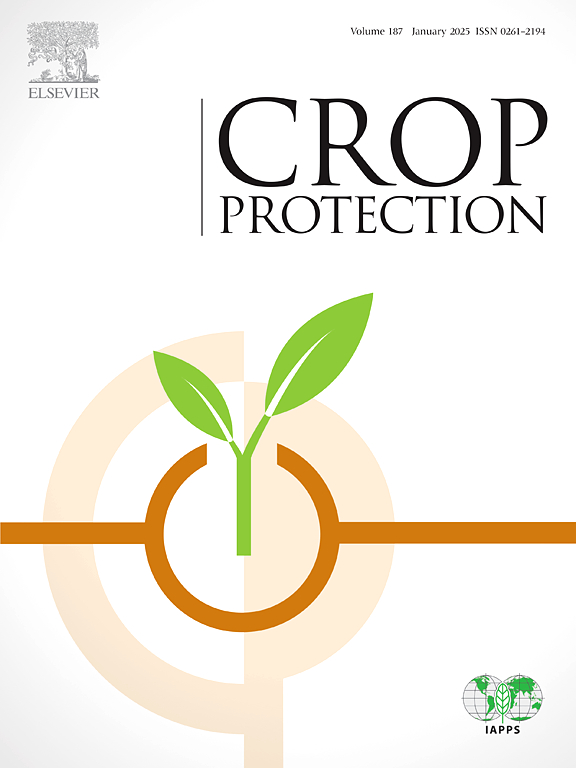铜、镁基纳米材料对辣椒细菌性斑病的防治效果
IF 2.5
2区 农林科学
Q1 AGRONOMY
引用次数: 0
摘要
辣椒细菌性斑病(BSP)是由黄单胞菌引起的一种重要病害,铜基杀菌剂被广泛应用于辣椒细菌性斑病的防治。这导致了病原体对铜的耐药性的发展。到目前为止,作为一种标准做法,已使用代森锰锌与铜材料混合而不是单独使用铜来控制BSP病原体的耐铜菌株。由于耐铜菌株的积累,需要一种铜杀菌剂的替代品。在前人防治番茄细菌性斑病研究的基础上,对核壳硅铜(CS-Cu)、铜基纳米材料以及氧化镁(MgO)、镁双包覆铜(MgDC)、镁铜(MgCu)等镁基纳米材料进行了体外和植物体防治番茄斑病的实验研究。在体外实验中,与商用铜杀菌剂(Kocide 3000)和对照相比,所有纳米材料在低至200 ppm的浓度下都具有杀菌活性,从减少100倍到完全消除活菌细胞不等。在生长室实验中,所有纳米材料浓度为100 μg/ml或更高时,与未处理的对照组相比,疾病严重程度降低了15%至56%。在现场实验中,除100 μg/ml的MgO和MgCu外,纳米材料与未处理对照相比,能使BSP严重程度降低12%至50%,而其效果与koide -3000相似。本文章由计算机程序翻译,如有差异,请以英文原文为准。
Effects of copper and magnesium-based nanomaterials in management of bacterial spot of pepper
Bacterial spot of pepper (BSP) is an important disease caused by Xanthomonas spp. Copper-based bactericides have been widely used to manage this disease over the decades. This has resulted in the development of copper resistance in the pathogen. To this date, as a standard practice, mancozeb mixed with a copper material has been used instead of copper alone to control copper-tolerant strains of the BSP pathogen. As a result of the build-up of copper-tolerant strains, there is a need for an alternative to copper bactericides. Based on results of previous studies for control of bacterial spot-on tomato, we tested core-shell silica copper (CS-Cu), a copper-based nanomaterial as well as some magnesium-based nanomaterials like magnesium oxide (MgO), magnesium double coated copper (MgDC) and magnesium copper (MgCu) in vitro and in planta against X. euvesicatoria. In the in vitro experiments, all nanomaterials had bactericidal activity at concentrations as low as 200 ppm, ranging from 100-fold reduction to complete elimination of viable bacterial cells as compared to the commercial copper bactericide (Kocide 3000) and the control. In growth chamber experiments all the nanomaterials at 100 μg/ml or higher reduced disease severity ranging from 15 % to 56 % less disease compared to theuntreated control. In field experiments nanomaterials except MgO and MgCu at 100 μg/ml were able to reduce BSP severity ranging from 12 % to 50 % compared to untreated control, whereas their efficacy remained similar to that of Kocide-3000.
求助全文
通过发布文献求助,成功后即可免费获取论文全文。
去求助
来源期刊

Crop Protection
农林科学-农艺学
CiteScore
6.10
自引率
3.60%
发文量
200
审稿时长
29 days
期刊介绍:
The Editors of Crop Protection especially welcome papers describing an interdisciplinary approach showing how different control strategies can be integrated into practical pest management programs, covering high and low input agricultural systems worldwide. Crop Protection particularly emphasizes the practical aspects of control in the field and for protected crops, and includes work which may lead in the near future to more effective control. The journal does not duplicate the many existing excellent biological science journals, which deal mainly with the more fundamental aspects of plant pathology, applied zoology and weed science. Crop Protection covers all practical aspects of pest, disease and weed control, including the following topics:
-Abiotic damage-
Agronomic control methods-
Assessment of pest and disease damage-
Molecular methods for the detection and assessment of pests and diseases-
Biological control-
Biorational pesticides-
Control of animal pests of world crops-
Control of diseases of crop plants caused by microorganisms-
Control of weeds and integrated management-
Economic considerations-
Effects of plant growth regulators-
Environmental benefits of reduced pesticide use-
Environmental effects of pesticides-
Epidemiology of pests and diseases in relation to control-
GM Crops, and genetic engineering applications-
Importance and control of postharvest crop losses-
Integrated control-
Interrelationships and compatibility among different control strategies-
Invasive species as they relate to implications for crop protection-
Pesticide application methods-
Pest management-
Phytobiomes for pest and disease control-
Resistance management-
Sampling and monitoring schemes for diseases, nematodes, pests and weeds.
 求助内容:
求助内容: 应助结果提醒方式:
应助结果提醒方式:


